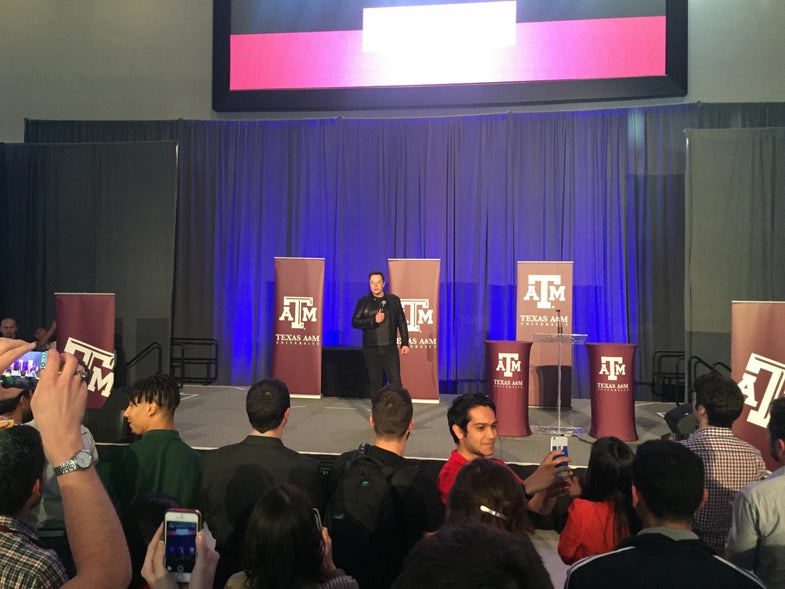MIT Wins SpaceX’s Hyperloop Pod Design Competition
With Elon Musk in attendance, the team bested 120-plus competitors

“Just one more important remark,” said Dr. Steve Davis, SpaceX’s director and emcee of this past Saturday’s first-ever Hyperloop pod design competition. “There’s been a hashtag that we’ve been using this whole time — #breakpod,” he said, after announcing the event’s winners. “But today another hashtag popped up: #whereisElon. I think we may be able to answer that question for you…”
As Elon Musk walked out on stage, the crowd immediately erupted into one loud, unified cheer. He was the reason they were all there. Challenged by Musk in his white paper that introduced the world to the Hyperloop, the 120-plus teams had spent months developing pods to help bring the concept one step further to reality (and a quick note, for those unfamiliar with the Hyperloop, which projects giant elevated tubes that will transport people in pods from city to city at speeds that can reach upwards of 800 miles per hour).
The weekend provided students from around the globe with a chance to finally unveil what the long hours had reaped. Teams put out swag, models, and interactive demonstrations on their booth tables to draw in viewers and other passerby to demonstrate their labor and attention to minute detail, including how the pods would move within the track to safety features and even materials and cost analyses. They were eager to unveil their designs.
The cream of the competition was the Massachusetts Institute of Technology’s graduate student team, which emerged as the top choice among teams in attendance from 20 countries and 27 U.S. states.

MIT’s winning rendering
The winning bid was a simple, elegant pod with the capacity to move at 110 meters per second. “We had a clear message: our pod was about making something safe, scalable and feasible,” said MIT team captain Philippe Kirschen. “I hope the judges appreciated the fact that we designed a pod that we believe is feasible to construct with a reasonable budget in a reasonable amount of time.”
MIT’s design features three key elements. Levitation skis use permanent magnet arrays that allow the pod to levitate off the aluminum track inside the steel Hyperloop tube. The design also includes two lateral stability modules to maintain attitude control within the track, and a fail-safe hydraulic braking mechanism that features wheels on either side of the pod and in the front and slows the pod when it is coming to a stop. All these elements help make the pod scalable, said Kirschen, which is an important design requirement that makes practical applicability feasible. For the purposes of the competition, the teams were offered the option to seat a half-scale dummy (MIT chose to ditch the dummy and focus on testing the pod at the highest speeds possible) but left unstated was the necessity for scaling up and seating more passengers.
And unlike many of its competitors, MIT elected to use an external propulsion system that will function more or less like the catapults used by aircraft carriers to launch aircraft from the middle of the ocean. This feature will offload some of the energy and power required by the Hyperloop concept onto the propulsion system, which means the pod doesn’t have to carry an engine and can be lighter (and reach ultra-high speeds).
According to Charlie Wheeler, who is also on Team MIT, five sub-teams focused on different aspects of the project, and members swapped responsibilities and handled various aspects of the pod, such as handling aerodynamics, electrical and software, structural, vehicle dynamics and business.
Kirschen’s team has already devised a detailed manufacturing plan, and armed with a budget of $106,000 (which includes building and testing the pod, as well as transportation to the competition), the hope is to implement it before competing, along with 21 other teams, at SpaceX this summer. They’ll test their pods at the company’s one-mile Hyperloop test track near its headquarters in Hawthorne, California, and according to Davis of SpaceX, the judging process will continue, and as many as 10 teams will be announced as winners in the coming weeks.
Most of the competitors had enlisted business or communications students to head up marketing efforts in an attempt to land sponsors, and MIT was no different, except they already had at least eight lined up before the weekend began. That didn’t stop Kirschen and company, armed with sophisticated presentation materials, from pounding the central Texas pavement to scrounge up more outside help. Some of the other teams had landed sponsors as well, but everyone was hoping the weekend would provide opportunities to connect with tech companies that might want to fund their work and allow them to turn their designs into reality.

But despite MIT’s advantages, like having more funding than many teams, the competition was tough. This, after all, was a gathering of some of the world’s most brilliant young minds in the field of engineering. Students flew in from India, Germany, Uzbekistan, Spain, Italy, the Netherlands, Australia, and around United States for a chance to get their ideas about the future of transportation out there.
“It’s been an incredible team effort, we’ve had a very hardworking team throughout and everyone has put an incredible amount of time into making this happen,” Kirschen said. “It feels really good [to win] because we are really happy the judges agreed with our design philosophy and we’re looking forward to making our pod a real thing.”